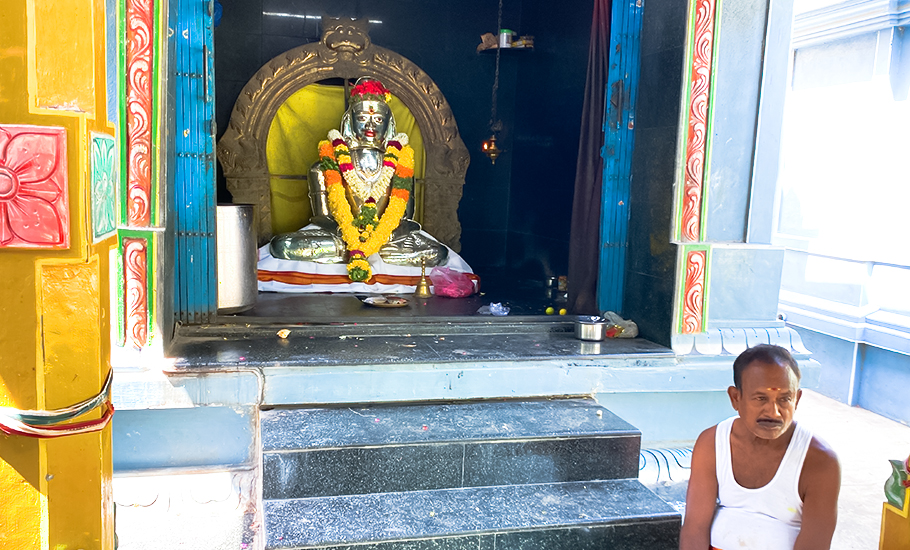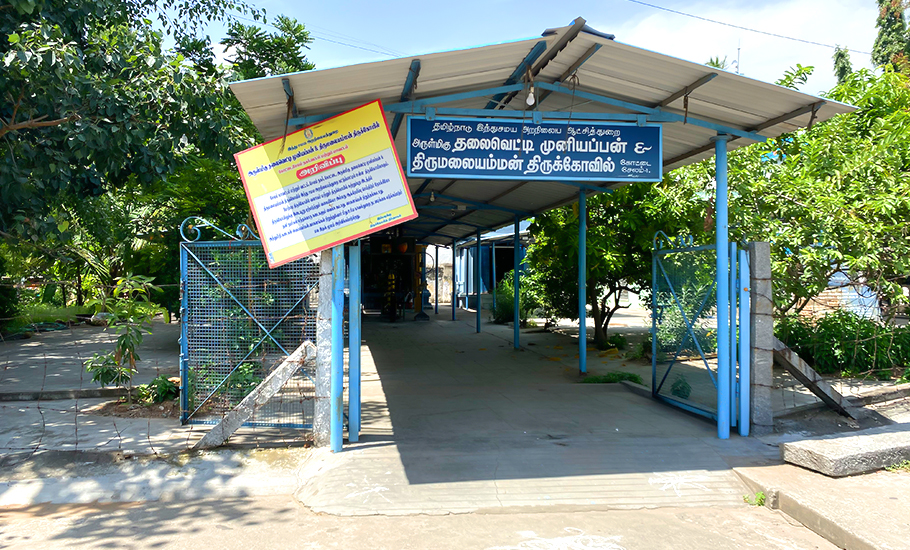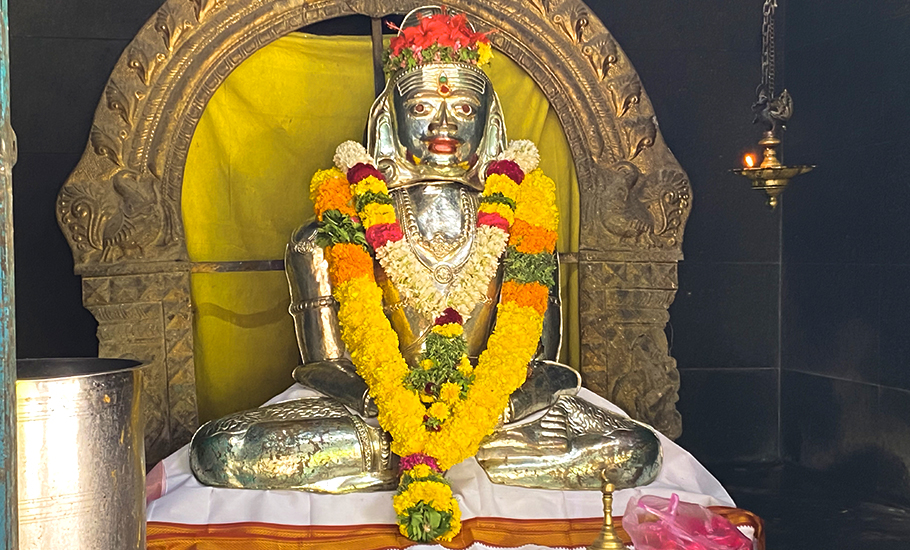
- Home
- News
- Analysis
- States
- Perspective
- Videos
- Education
- Entertainment
- Elections
- World Cup 2023
- Features
- Health
- Business
- Series
- Economy Series
- Earth Day
- Kashmir’s Frozen Turbulence
- India@75
- The legend of Ramjanmabhoomi
- Liberalisation@30
- How to tame a dragon
- Celebrating biodiversity
- Farm Matters
- 50 days of solitude
- Bringing Migrants Home
- Budget 2020
- Jharkhand Votes
- The Federal Investigates
- The Federal Impact
- Vanishing Sand
- Gandhi @ 150
- Andhra Today
- Field report
- Operation Gulmarg
- Pandemic @1 Mn in India
- The Federal Year-End
- The Zero Year
- Premium
- Science
- Brand studio
- Home
- NewsNews
- Analysis
- StatesStates
- PerspectivePerspective
- VideosVideos
- Entertainment
- ElectionsElections
- Sports
- Loading...
Sports - Features
- BusinessBusiness
- Premium
- Loading...
Premium

How Buddha became a Hindu god and landed in a Tamil Nadu temple

A child was born with some health complications in 1968. His worried parents didn’t know what to do with the baby since they did not have the resources to take the child to a hospital. At his wit’s end, the baby’s father Balraj Naidu placed him at the feet of Hindu god Thalaivetti Muniappan, at a temple in Periyeri village, part of Salem district of Tamil Nadu, and prayed for the...
A child was born with some health complications in 1968. His worried parents didn’t know what to do with the baby since they did not have the resources to take the child to a hospital. At his wit’s end, the baby’s father Balraj Naidu placed him at the feet of Hindu god Thalaivetti Muniappan, at a temple in Periyeri village, part of Salem district of Tamil Nadu, and prayed for the well-being of his son.
In what the family believes was a miracle, the child recovered and was soon smiling and taking baby steps to a ‘normal’ life. The family named the child Muniappan as a way of expressing gratitude, hoping naming the child after the god would ensure the deity’s continued blessings for the child.
Muniappan grew to be the priest of the temple following in the footsteps of his grandfather Govindraj Naidu and father Balraj. “Even before my grandfather, there were people who used to serve in the temple. But with my grandfather taking over as priest, the temple’s care has been with my family,” he says.
Muniappan would have continued happily in his traditional role through his life serving the deity in the temple only the deity is no longer who Muniappan, his father, grandfather and those taking care of the temple before them, thought He was.
On July 17, the Madras High Court passed an order in an 11-year-old case stating that the temple’s idol is not that of any Hindu deity but that of Buddha, which must be restored to its original form. For Muniappan, who refuses to believe that the court has given such an order, there is no other form of the deity, than the one he has seen since his childhood. But many living around the temple differ.
Differences over deity
Unmindful of what the court has said, Muniappan says the dispute is old and nothing will come out of it.
“These people claim the deity to be Buddha. But I don’t think the court has said anything as such. The dispute has been going on for years. Nothing has come out of it and the court would never say anything against the god,” Muniappan told The Federal when this reporter visited the site on August 13. He defended the low footfall The Federal saw, despite the day being a Saturday, claiming that the temple has regular devotees who visit the temple on a daily basis. “Since this month is dedicated to the worshipping of goddess Amman, people are visiting Muniappan in fewer numbers,” he says.
Some other residents of the area, who The Federal spoke to, agree with Muniappan and said that the court order won’t change anything on the ground.

Twenty-year-old Praneesh says that they will worship the idol irrespective of what the court believes it to be. “We don’t know whether the idol belongs to this religion or that religion. But we worship the idol as we worship other idols of our Hindu religion,” he says.
Many of those living in the vicinity of the temple, however, acknowledge that there were differences over the identity of the god for a long time and believe that the idol inside the temple was that of Buddha.
“We have been living in this house for generations and my grandfather used to tell us how the temple used to be under a tree when he was a child and how the concrete structures were built during the previous DMK regime between 2006 and 2011. We saw the statue without the decoration when it was moved during the renovation and it looked just like Buddha,” says Selvam, who lives on the Old Market Road that runs next to the temple.
What the court said
The Madras High Court has ordered the Tamil Nadu Archaeological Department to take control of the Thalaivetti Muniappan temple after it was found that the sculpture there was of Buddha.
The court order came on a case filed by P Ranganathan — who passed away in 2021 due to Covid — and the Buddha Trust in Salem in 2011 claiming that the Thalavetti Muniyappan Temple is a Buddhist site. The order came after an Archaeological Department investigation, directed by the court in 2017, found that the deity, Thalavetti Muniappan, was originally a sculpture of Buddha.
Also read | Main idol of Hindu temple in Salem, TN, is that of Buddha, rules Madras HC
In its report, the Archaeological Department said that after examining the available archaeological and historical evidence, it has reached the conclusion that the sculpture depicted several mahalakshanas of Buddha.
The report submitted in the court had said that the sculpture was made of hard stone. The figure was in a seated position known as ardhapadmasana (half lotus) on a lotus pedestal. The hands are posed in dhyana mudra (meditative posture)… The head shows lakshanas (features) of the Buddha such as curly hair, ushnisa (a three-dimensional oval at the top of the head of the Buddha) and elongated earlobe. Urna (spiral or circular dot placed on the forehead of Buddhist images) is not visible on the forehead.
Following the report, the court directed that the pooja and other Hindu rituals should be discontinued at the temple and that the Hindu Religious and Charitable Endowments department erect a board inside the property declaring that the sculpture inside is that of Buddha.
Even though the Madras HC has ordered the state’s Archaeological Department to restore the Muniappan statue into its original state on July 17, the temple is still under the control of Hindu Religious and Charitable Endowment department.
Also read | Reclaiming Buddha from TN Hindu temples a challenge: Buddhists
Asked about the transfer of control, a senior official associated with the Tamil Nadu Archaeological Department says that they are waiting for the copy of the order. “Once we get the order copy, we will write a letter to the HR&CE department and based on their reply, we will take over the site,” the official said.
How Buddha became a Hindu god
Petitioner Ranganathan’s friend C Murugan, a follower of Buddhism and Tamil Nadu state president of Ambedkarite Party of India, shares that Ranganathan was determined to prove the original identity of Muniappan.
“We all worked with him to see this happen. He wanted to visit the place after converting it into a Buddhist site. Unfortunately, he died before the order was passed,” Murugan shares, calling the judgment a first of its kind in the country.
“India was once a Buddhist nation and it was the Hindu and Muslim rulers who ran down the Buddha identity of the country,” Murugan claims.
According to Murugan, the name of Salem district itself shows Buddhist influence. “The name Salem itself was derived from the Buddha’s name Seelam. Similarly, Dharmapuri was derived from Dhamma Puri,” he says.
Concurring with Murugan, writer and historian Stalin Rajangam says that there are several identities of Buddha in the state of Tamil Nadu, drawing attention to the fact that many idols of Buddha were desecrated with their heads or nose being removed by those opposed to the Buddhist religion.

“Some of the idols are worshiped, some of them have been left alone and forgotten. Some of them are worshiped in the desecrated state itself, some of them are worshiped with the replaced heads of the local village deity,” he says.
According to Rajangam, in Thalaivasal town of Kallakurichi district, Buddha was named Kongu Siddhar, and in Puducherry’s Ariyankuppam, Buddha was named Brahma Rishi and both were worshiped for years without being beheaded.
“In Thanjavur, Buddha is named Sivanur. In Karur, Buddha is named Chettiyar. In none of these places Buddha is known as Buddha but is worshipped in accordance with Buddhist traditions,” he says.
Rajangam says Buddha gets a different name in different places and people continue worshipping him. “The Hindu religion in the case of Thalaivetti Muniappan did not change the name of the god but appropriated the Buddha name itself as that of a Hindu deity and claimed the idol too.”
Agreeing with Rajangam, Murugan says there were at least six structures of Buddha that were constructed in present-day Salem district by Ashoka, the third ruler of the illustrious Maurya dynasty, who wanted to build a Buddhist world.
“We cannot claim every identity, but at least after the court has ruled in favour of the Buddhists, it should be left for the Buddhists to practise their customs at the site,” he says.
Another follower of Buddhism, Seevagan, who embraced Buddhism around three years ago, says that the Buddhist site was necessary at least for congregation during Buddha Purnima.
“Buddhism is a religion of practice and not rituals. As Buddha himself has said that there is no god, we are not into idol worshiping, but we pay respect to Buddha and certain places are marked sacred as they are required by Buddha’s followers to pay respect to him and to congregate on the Purnima days,” Seevagan says.
Emphasising on the importance of claiming the site, Stalin Rajangam said religious and cultural identities are protected only when they were in practice and not when they are left untouched under state protection.
“People have been worshiping the god irrespective of their religious identity. People did not have a problem. It is the problem of the modern-day government. Now, following the court order, the Archaeological Department will protect the statue, but they cannot get people to worship or practice Buddhism,” he says.
On the other hand, Seevagan feels that protecting and asserting the identity is important as letting the status quo remain amounts to changing history.
“The Thalaivetti Muniappan temple, where Buddha was beheaded and where his head was placed again on the same structure, is evidence of how people from other religions appropriated the Buddha,” Seevagan feels.
Apart from desecrating the idol of Buddha, Stalin Rajangam says, beheading and cutting off the nose of the Buddha statue were part of the efforts to finish off Buddhism. “There were times when people were encouraged to behead Buddha saying that there would be treasure inside the statue,” he says.
How the idol in Thalaivetti Muniappan is restored to its original form and where that leaves believers such as Muniappan is a story that will unfold only with time.

